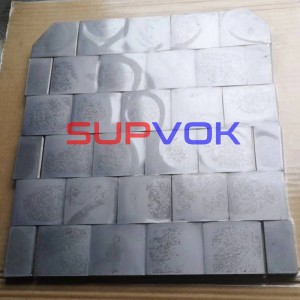With the development of technology, the destructive power of modern weapons is becoming stronger, and people’s attention to bulletproof materials is also increasing. Special ceramics, as a popular bulletproof material at present, have played an important role in the field of bulletproof. Special ceramics have the characteristics of high strength, high hardness, low density, corrosion resistance, and high wear resistance. They are lighter in weight and have a smaller load than metal bulletproof materials, making them extremely advantageous in individual bulletproof equipment such as bulletproof vests. At present, the bulletproof ceramics that have been applied in engineering mainly include alumina, zirconia, silicon carbide, boron carbide, aluminum nitride, silicon nitride, titanium borate, etc. Among them, silicon carbide is a ceramic material that has been extensively researched and applied domestically and internationally in recent years, and using silicon carbide as a bulletproof material has become a hot research topic both domestically and internationally.
Silicon carbide bulletproof plates have a low density and light weight, making them a significant advantage in individual bulletproof equipment. They are often used as lining for bulletproof vests, with a bulletproof level of up to the American standard of four. Silicon carbide bulletproof plates can be used as lining for bulletproof vests and protective devices for tanks and armored vehicles.
Silicon carbide (SC) mainly has two crystal structures, namely cubic B-SJC and hexagonal A-SC. It is a compound with strong covalent bonds, and its Si-C bond is only about 12% ionic. Therefore, compared to other ceramics such as alumina and boron carbide, it has better mechanical properties, oxidation resistance, higher wear resistance, and lower friction coefficient. In addition, it has good thermal stability, high high-temperature strength, and low thermal expansion coefficient The excellent characteristics of high thermal conductivity, good resistance to thermal shock and chemical corrosion have been favored by military experts from various countries and widely used.
The silicon carbide ceramic bulletproof sheet produced by Techkingceramic has a silicon carbide content of ≥ 99% and a hardness (HV0.5) of ≥ 2600.
1、 Advantages of silicon carbide ceramic bulletproof plates
Aluminum oxide, silicon carbide, and boron carbide are three commonly used materials in bulletproof ceramics. Alumina ceramic bulletproof sheets (commonly known as white sheets) have low hardness (HRA90) and high density among the three, but are cheap in price; Boron carbide ceramic bulletproof sheets have high hardness, low density, and the best performance among the three materials, but their prices are also far higher than the other two materials. In comparison, the hardness of silicon carbide ceramic bulletproof sheets (commonly known as black sheets) can reach HRA92, and the density is only 82% of that of aluminum oxide bulletproof sheets, making them affordable and widely used.
Silicon carbide (SiC) mainly has two crystal structures, namely cubic crystal system β- SiC and hexagonal crystal systems α- SiC is a compound with strong covalent bonds, and the ionic type of its Si-C bond is only about 12%. Therefore, compared to other ceramics such as alumina and boron carbide, it has better mechanical properties, oxidation resistance, higher wear resistance, and lower friction coefficient. In addition, it has good thermal stability, high high-temperature strength, and low thermal expansion coefficient The excellent characteristics of high thermal conductivity, good resistance to thermal shock and chemical corrosion have been favored by military experts from various countries and widely used.
However, the fatal drawback of low resilience is still an urgent problem to be solved. The molecular structure and characteristics of silicon carbide determine its low toughness. When hit by a bullet, its ultra-high strength can completely resist the enormous kinetic energy of the bullet and instantly shatter it. However, it can also crack or even break into pieces at the moment of impact, making silicon carbide ceramic plates only usable as disposable inserts and usually unable to withstand multiple consecutive shots. However, many researchers in the field of material molecular biology currently suggest that the low toughness of silicon carbide can theoretically be compensated for and overcome by controlling the sintering process and ceramic fiber weaving. This will greatly expand the application range of silicon carbide in the field of bulletproof equipment, making it an ideal material for manufacturing bulletproof equipment.
2、 The bulletproof principle of silicon carbide ceramic bulletproof plate
The basic principle of armor protection is to consume bullet energy, slow down bullets, and achieve harmlessness. The vast majority of traditional engineering materials, such as metal materials, absorb energy through structural plastic deformation, while ceramic materials absorb energy through micro crushing processes.
The energy absorption process of silicon carbide bulletproof ceramics can be roughly divided into three stages:
(1) Initial impact stage: The bullet impacts the ceramic surface, making the warhead blunt and absorbing energy during the process of crushing and forming small and hard fragments on the ceramic surface;
(2) Erosion stage: The blunt bullets continue to erode the fragmented area, forming a continuous layer of ceramic fragments;
(3) Deformation, cracking, and fracture stages: Finally, tensile stress is generated in the ceramic, causing it to shatter. Subsequently, the back plate deforms, and all remaining energy is absorbed by the deformation of the back plate material. During the process of bullet impact on ceramics, both the bullet and the ceramics are damaged.
From the perspectives of performance, price, and development prospects, silicon carbide bulletproof ceramics have high research value, and their applications in the bulletproof field will become increasingly widespread!
Post time: Aug-29-2023





